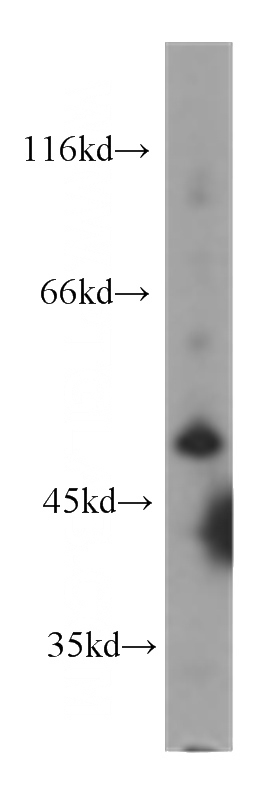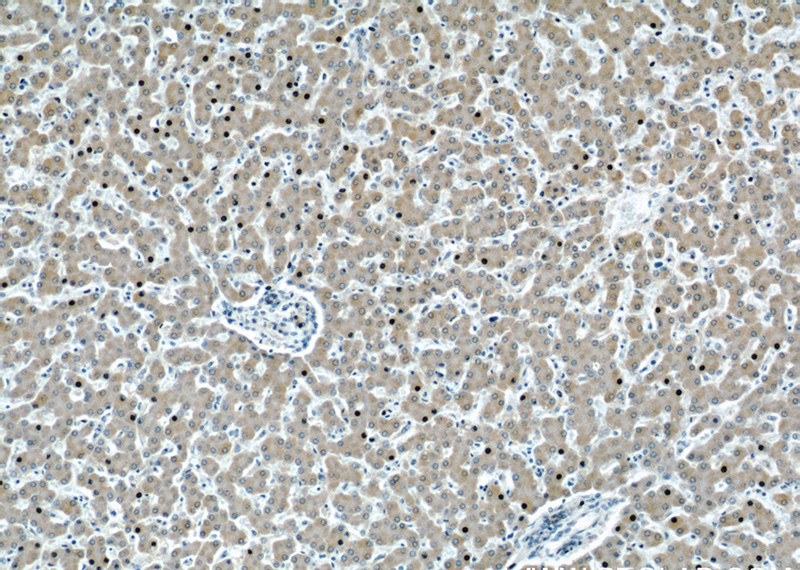-
Product Name
Angiotensinogen antibody
- Documents
-
Description
Angiotensinogen Mouse Monoclonal antibody. Positive IHC detected in human liver cancer tissue, human kidney tissue, human liver tissue. Positive WB detected in Hepg2 cell. Observed molecular weight by Western-blot: 52 kDa
-
Tested applications
ELISA, WB, IHC
-
Species reactivity
Human; other species not tested.
-
Alternative names
AGT antibody; Ang I Angiotensin 2 antibody; Ang II Angiotensin 3 antibody; Ang III antibody; Angiotensin I antibody; Angiotensin II antibody; Angiotensin III antibody; Angiotensinogen antibody; ANHU antibody; Des Asp[1] angiotensin II antibody; FLJ92595 antibody; FLJ97926 antibody; Serpin A8 antibody; SERPINA8 antibody
-
Isotype
Mouse IgG2b
-
Preparation
This antibody was obtained by immunization of Angiotensinogen recombinant protein (Accession Number: NM_000029). Purification method: Protein A purified.
-
Clonality
Monoclonal
-
Formulation
PBS with 0.1% sodium azide and 50% glycerol pH 7.3.
-
Storage instructions
Store at -20℃. DO NOT ALIQUOT
-
Applications
Recommended Dilution:
WB: 1:500-1:5000
IHC: 1:20-1:200
-
Validations

HepG2 cells were subjected to SDS PAGE followed by western blot with Catalog No:107054(AGT antibody) at dilution of 1:1000

Immunohistochemical of paraffin-embedded human liver cancer using Catalog No:107054(AGT antibody) at dilution of 1:50 (under 10x lens)

Immunohistochemical of paraffin-embedded human liver cancer using Catalog No:107054(AGT antibody) at dilution of 1:50 (under 40x lens)

Immunohistochemical of paraffin-embedded human liver using Catalog No:107054(AGT antibody) at dilution of 1:50 (under 10x lens)

Immunohistochemical of paraffin-embedded human liver using Catalog No:107054(AGT antibody) at dilution of 1:50 (under 40x lens)
-
Background
Angiotensinogen is a precursor of angiotensin II (Ang II), is expressed and synthesized largely in the liver and is cleaved by the enzyme renin in response to lowered blood pressure. It has a key role in mediating vascular constriction and regulating salt and fluid homeostasis. The resulting product, angiotensin I, is then cleaved by angiotensin converting enzyme (ACE) to generate the physiologically active enzyme angiotensin II. Mutations in this gene are associated with susceptibility to essential hypertension, and can cause renal tubular dysgenesis, a severe disorder of renal tubular development. Defects in this gene have also been associated with non-familial structural atrial fibrillation, and inflammatory bowel disease.
Related Products / Services
Please note: All products are "FOR RESEARCH USE ONLY AND ARE NOT INTENDED FOR DIAGNOSTIC OR THERAPEUTIC USE"
